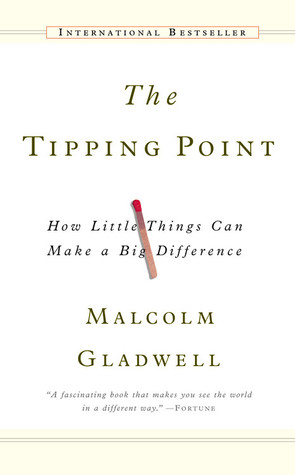
** How little things can make a big difference
** The tipping point is that magic moment when an idea, trend, or social behavior crosses a threshold, tips, and spreads like wildfire. Just as a single sick person can start an epidemic of the flu, so too can a small but precisely targeted push cause a fashion trend, the popularity of a new product, or a drop in the crime rate.
** There are so many theories behind the production of Sesame Street.
Notes
- Ideas and products and messages and behaviors spread just like viruses do.
- It takes only the smallest of changes to shatter an epidemic’s equilibrium.
- The three rules of the Tipping Point — the Law of the Few, the Stickiness Factor, the Power of Context — offer a way of making sense of epidemics.
- The law of the few
- A very small number of people are linked to everyone else in a few steps, and the rest of us are linked to the world through those special few.
- Connectors are the kinds of people who know lots of people.
- Connectors are people whom all of us can reach in only a few steps because, for one reason or another, they manage to occupy many different worlds and subcultures and niches.
- The word Maven means one who accumulates knowledge.
- In a social epidemic, Mavens are data banks. They provide the message. Connectors are social glue: they spread it. But there is also a select group of people – Salesmen – with the skills to persuade us when we are unconvinced of what we are hearing, and they are as critical to the tipping of word-of-mouth epidemics as the other two groups.
- The question of what makes someone – or something – persuasive is a lot less straightforward than it seems.
- The stickiness factor
- Sesame Street, Blue’s Clues, and the educational virus
- The line between hostility and acceptance in other words, between an epidemic that tips and one that does not, is sometimes a lot narrower than it seems.
- There is a simple way to package information that, under the right circumstances, can make it irresistible.
- The power of context
- Epidemics are sensitive to the conditions and circumstances of the times and places in which they occur.
- The broken windows theory: if a window is broken and left unrepaired, people walking by will conclude that no one cares and no one is in charge. Soon, more windows will be broken, and the sense of anarchy will spread from the building to the street on which it faces, sending a signal that anything goes.
- Broken Windows theory and the Power of Context are one and the same. They are both on the premise that an epidemic can be reversed, can be tipped, by tinkering with the smallest details of the immediate environment.
- The Rule of 150: “The figure of 150 seems to represent the maximum number of individuals with whom we can have a genuinely social relationship, the kind of relationship that goes with knowing who they are and how they relate to us. Putting it another way, it’s the number of people you would not feel embarrassed about joining uninvited for a drink if you happened to bump into them in a bar.”
- Case study
- What Mavens and Connectors and Salesmen do to an idea in order to make it contagious is to alter it in such a way that extraneous details are dropped and others are exaggerated so that the message itself comes to acquire a deeper meaning.
- if anyone whats to start an epidemic, then he or she has to somehow employ Connectors, Mavens, and Salesmen in this very way: he or she has to find some person or some means to translate the message of the Innovators into something the rest of us can understand.
- The people who die in highly publicized suicides — whose deaths give others permission” to die — serve as the Tipping Points in suicide epidemics.
- It is important to keep these two concepts — contagiousness and stickiness — separate, because they follow very different patterns and suggest very different strategies.
- Contagiousness is in larger part a function of the messenger. Stickiness is primarily a property of the message.
- Conclusion
- Starting epidemics requires concentrating resources on a few key areas. The Law of the Few says that Connectors, Mavens, and Salesmen are responsible for starting word-of-mouth epidemics, which means that if you are interested in starting a word-of-mouth epidemic, your resources ought to be solely concentrated on those three groups. No one else matters.
- The world — much as we want it to — does not accord with our intuition. Those who are successful at creating social epidemics do not just do what they think is right. They deliberately test their intuitions.
